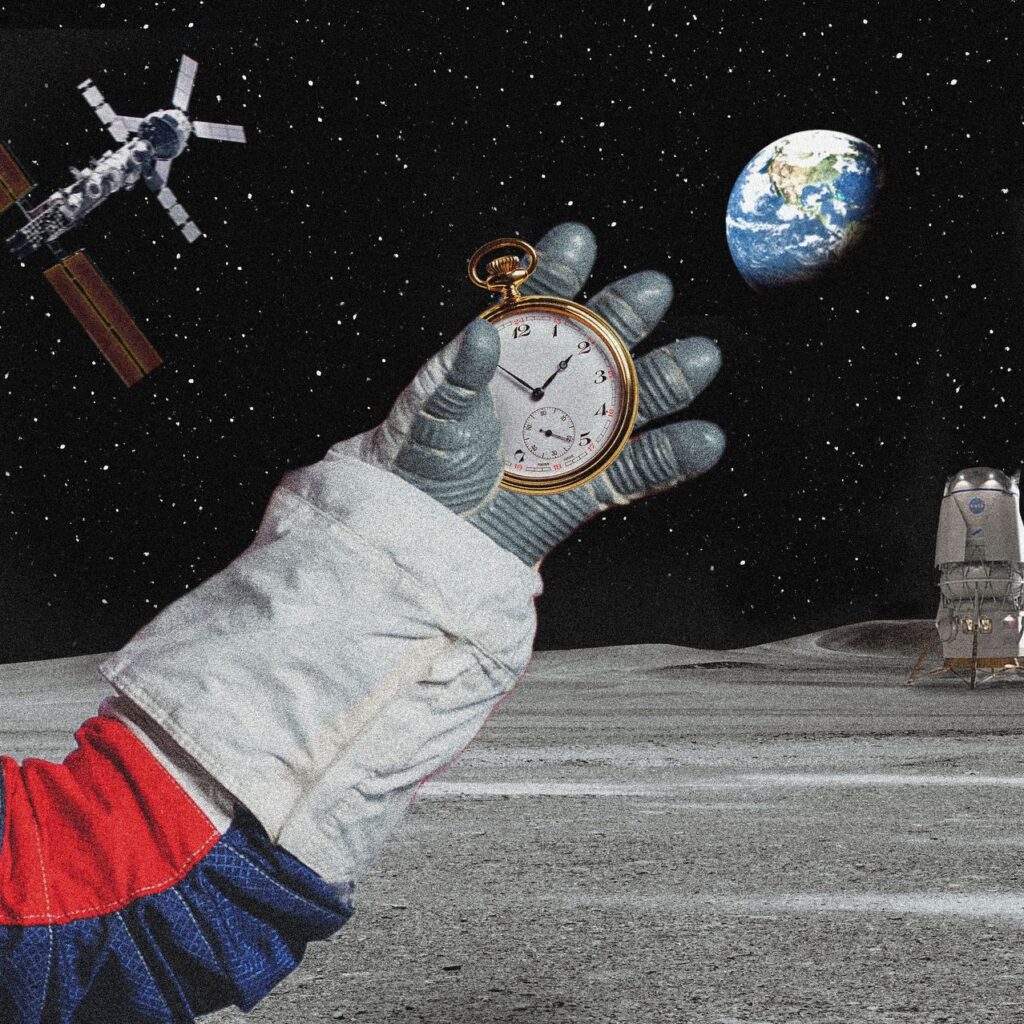
Question Sounds Silly…But No Easy Answer!
At first bluff, this sounds like esoteric philosophy, along the lines of “if a tree falls in the forest and nobody is there to hear it, does it make a sound?” A recent Wall Street Journal article, however, makes it clear that it warrants attention.1 The implications are actually quite important, especially if dreams of a lunar-based economy are ever to come to fruition. Thanks to the magic of relativity, if you synchronize two clocks and then place one on the surface of the Earth and one on the surface of the Moon, after 24 hours the lunar clock would be ahead by about 56 microseconds. Not too terrible, right? Wrong. The Journal explains that a difference of a single microsecond could result in an estimated position error of up to a mile while using the current Global Positioning System (GPS) employed on Earth. They drive home this consideration’s grave significance with a simple thought experiment: “Compound that error by at least 56 times for every day of a lunar mission’s lifespan, and suddenly the idea of a rocket hurtling towards the moon at 25,000 mph and then needing to slow down to slot into a congested lunar orbit sounds precarious.” I would not feel too comfortable flying commercially if I knew the air traffic control’s estimates of each plane’s position could be off by 56 miles by the end of the day.
Turning to the Earthly analogy, you don’t have to think too deeply to realize how much chaos the global economy would be plunged into if every country, or even every state or city decided they were going to adopt their own time standard. You want to know that when your flight lands in another city, you can accurately forecast what time it is there, or you may kiss your connecting flight goodbye. On a grander scale, trades on the stock market rely on precisely coordinated timing systems to prevent anyone from getting an unfair advantage, an important consideration in constructing a system that is globally trusted.2 Thankfully, we have the 1967 adoption of Coordinated Universal Time (UTC) keeping us from teetering over into such chaos.3 Localities are free under the laws of their countries to establish their own timing metrics off of this (such as the disparity between states that do and do not subscribe to Daylight Savings Time), but there is at least a common accepted standard underlying it. Mechanisms such as leap seconds maximize the accuracy of this timing system.
The Cyber Implications
The Wall Street Journal article cites an April 2024 White House document, the “Memorandum for Departments and Agencies Participating in the White House Cislunar Technology Strategy Interagency Working Group.”4 This document lays out four basic requirements for the establishment of such a lunar time standard: “(1) Traceability to UTC, (2) Accuracy sufficient to support precision navigation and science, (3) Resilience to loss of contact with Earth, and (4) Scalability to space environments beyond the Earth-Moon system.” This list is particularly illuminating because it highlights aspects that go beyond the simple establishment of a time standard as discussed in the Wall Street Journal–it has some very specific expectations with its technical performance and resilience, and those are very much in the purview of cybersecurity.
Our GPS satellites are key enablers of precision Positioning, Navigation, and Timing (PNT). It is that last aspect, timing, that often gets short shrift. It’s not enough to have a globally agreed-upon standard; you must have a means of guaranteeing the accuracy of that standard. With a significant reliance on satellites, you need to take relativity into consideration, meaning that very small perturbations in the chosen timing mechanism can have drastic physical implications. Where an adversary might try to attack the watchdog timer of a computer system, think of how much more havoc could be wrought if they attacked the “watchdog timer” of the system-of-systems at the very top of the economy? We have the opportunity of a relatively blank slate when it comes to establishing the PNT architecture for cislunar space. The significant distance from Earth highlights the need for physical and cyber resilience, and will probably require heavy automation beyond even what is employed in the GPS network. Cybersecurity cannot be an afterthought, especially in the supply chain as the initial infrastructure is built. There won’t be much opportunity for do-overs if we get the initial infrastructure lay-down wrong.
The takeaway questions from this examination: who will be in charge of establishing the timing standard, an existing Earthbound organization like the United Nations, or a “working group” structure similar to the Artemis Accords? What technologies will enable new approaches that build upon the strengths and avoid some of the weaknesses of the current GPS architecture? What additional layers of autonomy and mission assurance are required for the remoteness of cislunar space? How do you guard against a malicious actor manipulating the precision timing signal, or prevent a blunt-force denial of service? All these must be addressed in building the cislunar economy.
Sources
- Aylin Woodward, “A New Space Mission: How to Tell Time on the Moon,” The Wall Street Journal, published 08 August 2024, https://www.wsj.com/science/space-astronomy/moon-time-nasa-mission-650b6c36, accessed 12 August 2024. ↩︎
- White Paper, “The Significance of Accurate Timekeeping and Synchronization in Trading Systems,” Safran, https://safran-navigation-timing.com/timekeeping-and-synchronization-in-trading-systems/#:~:text=A%20delay%20of%20a%20few,efficient%20trading%20for%20all%20participants., accessed 12 August 2024. ↩︎
- Various Authors, “Coordinated Universal Time,” Wikipedia, https://en.wikipedia.org/wiki/Coordinated_Universal_Time, accessed 12 August 2024. ↩︎
- Arati Prabhakar, “Memorandum for Departments and Agencies Participating in the White House Cislunar Technology Strategy Interagency Working Group,” Executive Office of the President, Office of Science and Technology Policy, 02 April 2024, https://www.whitehouse.gov/wp-content/uploads/2024/04/Celestial-Time-Standardization-Policy.pdf, accessed 12 August 2024. ↩︎